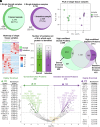Single-tissue proteomics in Caenorhabditis elegans reveals proteins resident in intestinal lysosome-related organelles
- PMID: 38861598
- PMCID: PMC11194598
- DOI: 10.1073/pnas.2322588121
Single-tissue proteomics in Caenorhabditis elegans reveals proteins resident in intestinal lysosome-related organelles
Abstract
The nematode intestine is the primary site for nutrient uptake and storage as well as the synthesis of biomolecules; lysosome-related organelles known as gut granules are important for many of these functions. Aspects of intestine biology are not well understood, including the export of the nutrients it imports and the molecules it synthesizes, as well as the complete functions and protein content of the gut granules. Here, we report a mass spectrometry (MS)-based proteomic analysis of the intestine of the Caenorhabditis elegans and of its gut granules. Overall, we identified approximately 5,000 proteins each in the intestine and the gonad and showed that most of these proteins can be detected in samples extracted from a single worm, suggesting the feasibility of individual-level genetic analysis using proteomes. Comparing proteomes and published transcriptomes of the intestine and the gonad, we identified proteins that appear to be synthesized in the intestine and then transferred to the gonad. To identify gut granule proteins, we compared the proteome of individual intestines deficient in gut granules to the wild type. The identified gut granule proteome includes proteins known to be exclusively localized to the granules and additional putative gut granule proteins. We selected two of these putative gut granule proteins for validation via immunohistochemistry, and our successful confirmation of both suggests that our strategy was effective in identifying the gut granule proteome. Our results demonstrate the practicability of single-tissue MS-based proteomic analysis in small organisms and in its future utility.
Keywords: lysosome-related organelle; microproteomics; tissue-specific mass-spectrometry; yolk protein.
Conflict of interest statement
Competing interests statement:The authors declare no competing interest.
Figures






References
-
- Sulston J. E., Horvitz H. R., Post-embryonic cell lineages of the nematode, Caenorhabditis elegans. Dev. Biol. 56, 110–156 (1977). - PubMed
-
- Hedgecock E. M., White J. G., Polyploid tissues in the nematode Caenorhabditis elegans. Dev. Biol. 107, 128–133 (1985). - PubMed
-
- Ashrafi K., et al. , Genome-wide RNAi analysis of Caenorhabditis elegans fat regulatory genes. Nature 421, 268–272 (2003). - PubMed
MeSH terms
Substances
Grants and funding
LinkOut - more resources
Full Text Sources

